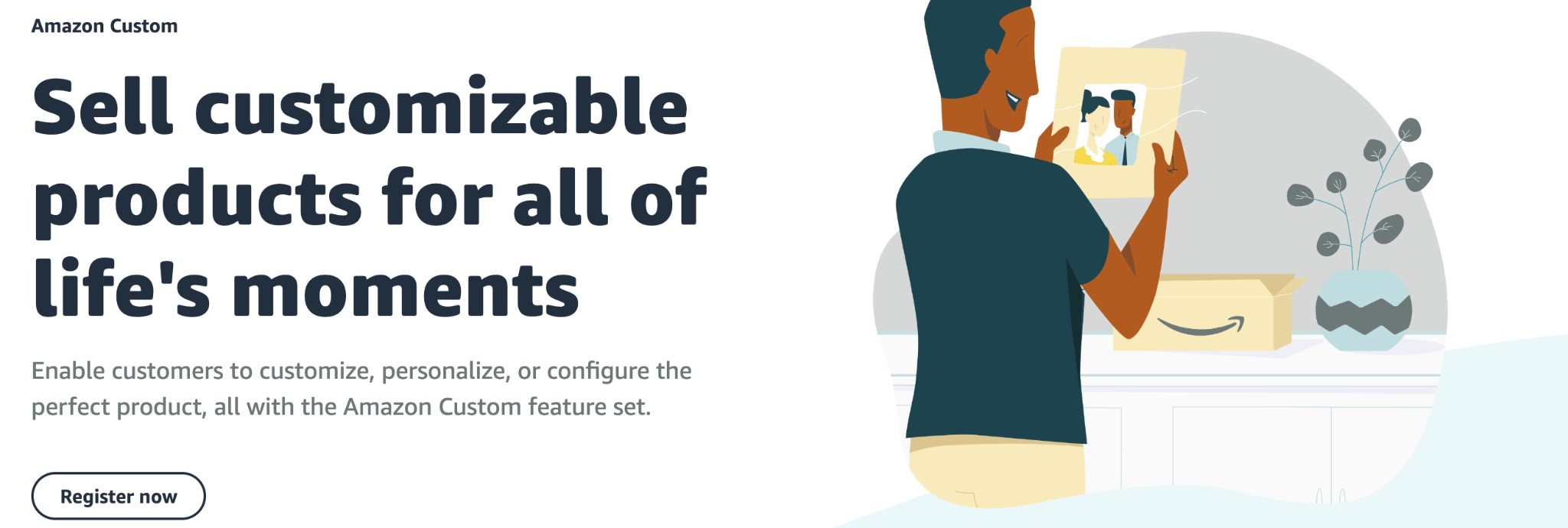Back to Page
Amazon
TL;DR
Amazon Custom enables customers to personalize products with text, images, and configurations, enhancing the shopping experience
Setting up an Amazon Custom account involves registering, creating products in Seller Central, and specifying customization details
Costs include a professional seller account fee, with additional features in Amazon Custom currently free but subject to change
By providing individualized products for sale on Amazon, sellers and manufacturers have an exceptional opportunity to directly cater to the preferences of their customers, adding a unique touch that can differentiate their products from those of competitors. This strategy not only helps sellers build a brand that appeals to consumers who value customized options, but it also satisfies the demands of customers searching for unique products.
Amazon Custom is a storefront on Amazon that offers customizable products from professional sellers. The basics of listing and selling customized products on Amazon will be covered in this blog, including how to create product listings, and common questions associated with the service will be answered.
What is Amazon Custom?

Amazon Custom is a specialized Amazon storefront that allows professional sellers to offer customizable products. Here, customers can customize their purchases with text, photographs, or logos of their own, or they can choose from a range of alternatives provided by the seller. With this service, customers can personalize something to fit their needs and interests, adding an engaging element to typical purchases. Products made accessible through Amazon Customs are also included in the seller's designated department to provide accessibility through both the custom store and the wider Amazon marketplace. This invention allows customers to purchase fully customized goods and allows sellers to offer a greater selection of products.
How does Amazon Custom work?
Selling customized products on Amazon Custom's marketplace is made easier. Using Amazon's Seller Central, sellers first build up their customizable listings. This entails specifying which features of their products—like color, text, or uploaded images—can be altered. The options that are accessible for each configurable feature can also be specified by sellers.
Customers can browse through a choice of products that can be customized to their liking when they visit Amazon Custom. Customers can insert text, upload photographs, and choose from predefined options through an interactive customizing interface that walks them through the purchase process. Amazon's tools, which easily interface with the seller's listings, make this dynamic experience possible.
Once the customization details are submitted by the customer, the order, along with the specific customization requests, is forwarded to the seller. Sellers then produce the item according to the custom specifications and ship it directly to the customer. Amazon handles customer service and returns, just as it does with non-custom products, ensuring a consistent shopping experience across its platform. This system not only provides a unique shopping experience but also allows sellers to offer more personalized products without having to manage a separate storefront.
How much does it cost to sell on Amazon Custom?
With Amazon Custom, sellers may offer personalized products at no additional cost because the personalization options are free of charge. Standard Amazon fees, such as selling and membership fees, still apply, though. Although the features are currently free, Amazon adds that future updates may incur fees. Sellers should stay informed about updates to manage potential expenses effectively.
What products can you sell on Amazon Custom?

Here’s a list of products sellers can sell on Amazon Custom’s main categories:
Home & Kitchen
Clothing, shoes & jewelry
Handmade
Sports & outdoors
Office products
Baby
Pet supplies
Automotive parts & accessories
Cell phones & accessories
Arts, crafts & sewing
Toys & games
Collectibles & fine art
Products ineligible for customization on Amazon Custom include:
Media
Personal computers
Laptops
Computer towers
Tablets
Video consoles
Additionally, sellers must be authorized to sell within the specific category of their custom products. For example, without approval to sell in the jewelry category, sellers cannot offer customizable necklaces on Amazon Custom.
What are the types of product customizations you can offer?
To accommodate each customer's interests and tastes, Amazon Custom provides a variety of ways for users to customize products. The kinds of customizations that sellers can provide are as follows:
Text customization: Using this feature, customers can add their text to the products. Sellers can specify various aspects including character limits, colors, and font types. There are several ways to apply this personalization, including engraving, printing, and embroidery.
Image customization: To further customize the product, customers can submit their images. This tool, which lets users add text overlays to their photographs, frequently goes well with text personalization. The permissible picture dimensions and placement guidelines can be specified by sellers.
Product configuration: Sometimes referred to as the "list of options," this feature allows users to customize a product by selecting from pre-made options. With Seller Central, sellers can provide options via drop-down menus that hold up to 100 options. Furthermore, sellers are free to impose additional fees for certain customizations.
What are the eligibility requirements to sell on Amazon Custom?
To sell on Amazon Custom, sellers must pay a $39.99 monthly subscription fee to become a professional seller. You have to fulfill this specific need to sell customized goods through Amazon Customs. However, it's important to keep in mind that sellers who take part in the Amazon Handmade program are exempted from this obligation. Distinct from the main Amazon Custom framework, Amazon Handmade is a platform designed specifically for artisans to market their handmade products.
How to set up an Amazon Custom account and then create a listing for Amazon Custom?

Register for Amazon Custom: Applying to join Amazon Custom is the first step. This procedure includes completing an application, after which Amazon will determine whether your products fulfill the requirements for customizable products. To apply, you need to have an account with a professional seller. Amazon will give you all the instructions and a link to get started as soon as you are accepted.
Add a new product in Amazon Seller Central: Go to the "Inventory" section of your Amazon Seller Central account after logging in. In this instance, choose "Add a Product," then pick "I'm adding a product not sold on Amazon." This lets you start from scratch when creating a new Amazon product listing. You must choose the relevant product category and complete the necessary areas, including those for product variations, pricing, pictures, and thorough descriptions. It’s crucial to ensure the category is relevant to your product to optimize its visibility in search results.
Customize your product details: Go ahead and add customization options after making your product listing. Find your product on the "Manage Inventory" dashboard, then click the drop-down menu and choose "Add/Edit Customization Information." In this phase, you outline the customizable choices you provide, such as uploading images or customizing text. You can configure settings like the maximum character limit, the permitted fonts and colors, and the ability for consumers to add their photographs.
Review and test your listing: After you've added your modification data, go over the whole thing to make sure everything is correct and the customization options function as they should. It is imperative to verify that every component of your product description accurately represents what you provide and that the customization interface is easy to use.
Launch and monitor your product: You can now launch your product setup after giving it a thorough test. Pay special attention to how consumers use the customization features and adapt as needed in response to customer feedback and performance metrics.
FAQs
How long does it take to get approved for Amazon Custom?
Approval for Amazon Custom is typically instantaneous, and you'll receive an email with setup instructions within an hour if approved.
Can you bulk upload products to Amazon Custom?
Bulk upload is available for products with simple text customizations. More complex customizations involving images or multiple options require individual uploads.
How many customization options can be added to a product?
You can offer up to 100 customization options across five surfaces on a single product, incorporating text, image, and product customizations.
Does FBA seller services handle Amazon Custom orders?
No, FBA does not fulfill Amazon Custom orders due to the personalized nature of products. Sellers must manage fulfillment independently.
Can Amazon Custom products be advertised on Amazon?
Yes, Amazon Custom products can be advertised using Sponsored Products ads, targeting relevant search terms related to customization.
Is there a limit on the number of customizations per product?
A single product can have up to 100 customizations, distributed across up to five customizable surfaces.
Can customized products be returned?
Customized products generally cannot be returned but might be eligible for a refund or replacement depending on the issue.
How does Amazon handle inappropriate content in customizations?
Amazon reviews customized content to ensure it complies with their conditions of use and community guidelines. Inappropriate content is not allowed.
Can businesses personalize products with their logos on Amazon Custom?
Yes, businesses can use the image customization feature to add their logos to products, making it ideal for corporate branding.
What are the main reasons for Amazon Custom order rejections?
Rejections may occur if the customization request violates Amazon's content guidelines or if the requested customizations are not feasible due to technical limitations.
Conclusion
In conclusion, a seller can significantly increase their product offers by effectively leveraging Amazon Custom by permitting customized adaptations that directly cater to client preferences. By fully understanding Amazon Custom's features —including the range of customization options available, inventory control and order fulfillment strategies, and the finer points of advertising and return handling— sellers can maximize their online presence and profit on one of the largest worldwide e-commerce platforms. When utilized effectively, Amazon Custom offers a unique opportunity to attract a large customer base of shoppers looking for that extra something in their purchases, increasing customer satisfaction and seller revenue.
For sellers aiming to excel in selling custom products on Amazon, partnering with eStore Factory can provide the essential support and expertise needed. eStore Factory specializes in assisting sellers to navigate the complexities of Amazon, including the intricacies of Amazon Custom. From Amazon seller account management, and handling inventory to optimizing product listings and executing effective PPC campaigns, eStore Factory's Amazon experts help ensure that your custom products reach the right audience efficiently and effectively.









